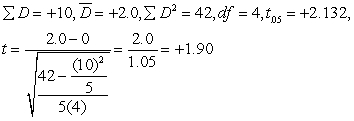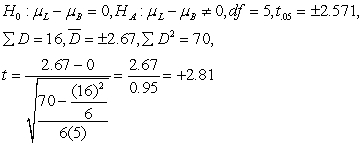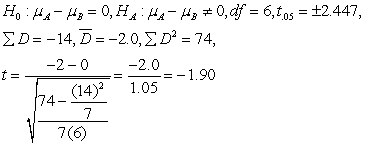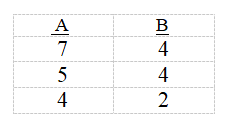Deck 15: Testing for a Difference
Question
Question
Question
Question
Question
Question
Question
Question
Question
Question
Question
Question
Question
Question
Question
Question
Question
Question

Unlock Deck
Sign up to unlock the cards in this deck!
Unlock Deck
Unlock Deck
1/18
Play
Full screen (f)
Deck 15: Testing for a Difference
1
The following are the scores for the same five individuals obtained under both experimental and control conditions:

 Test
Test  against
against  > 0 ( = .05) and draw final conclusions.
> 0 ( = .05) and draw final conclusions.

 Test
Test  against
against  > 0 ( = .05) and draw final conclusions.
> 0 ( = .05) and draw final conclusions. 
retain
 ; the results are not strong enough to conclude that there is a difference.
; the results are not strong enough to conclude that there is a difference. 2
We wish to compare reaction time to sound with reaction time to light. In a carefully controlled experiment, the time required to react to a buzzer and the time required to react to a white signal light are obtained for each of six subjects. The following are the results (in milliseconds):
 Set up the statistical hypotheses; perform the test (α = .05), and draw final conclusions.
Set up the statistical hypotheses; perform the test (α = .05), and draw final conclusions.
 Set up the statistical hypotheses; perform the test (α = .05), and draw final conclusions.
Set up the statistical hypotheses; perform the test (α = .05), and draw final conclusions.
reject

; conclude

reaction time is longer to the light.
3
A tire manufacturer wishes to compare two designs for fiberglass belted tires with regard to tread wear. One tire of each design is placed on the rear wheels of each of seven test automobiles that are inspected regularly. The elapsed mileage until replacement is necessary is recorded for each tire. The following are the results (to the nearest 1000 miles):
 Set up the statistical hypotheses; perform the test (α = .05) and draw final conclusions.
Set up the statistical hypotheses; perform the test (α = .05) and draw final conclusions.
 Set up the statistical hypotheses; perform the test (α = .05) and draw final conclusions.
Set up the statistical hypotheses; perform the test (α = .05) and draw final conclusions.
retain

; the evidence is insufficient to conclude that there is a difference in tread wear.
4
You wish to compare two different orders of presentation (A and B) of the items on a standard IQ test administered to a representative group of 10-year-olds. The test is constructed to give a standard deviation of 15 IQ points in a representative group at any age level. What is the probability of detecting a true difference (
of 5 IQ points (two-tailed test, ) if each of the two samples is of size:
) if each of the two samples is of size:

(a)10?
(b)20?
(c)40?
(d)80?
(e)200?

of 5 IQ points (two-tailed test,
 ) if each of the two samples is of size:
) if each of the two samples is of size:
(a)10?
(b)20?
(c)40?
(d)80?
(e)200?

Unlock Deck
Unlock for access to all 18 flashcards in this deck.
Unlock Deck
k this deck
5
Observations are dependent when
A) the same subjects have been used for both sets of observations
B) subjects have been matched on some variable related to the variable observed
C) either of the above is true
D) the mean of X exactly equals the mean of Y
A) the same subjects have been used for both sets of observations
B) subjects have been matched on some variable related to the variable observed
C) either of the above is true
D) the mean of X exactly equals the mean of Y

Unlock Deck
Unlock for access to all 18 flashcards in this deck.
Unlock Deck
k this deck
6
When samples are dependent, the standard error of the difference between two means will be
A) larger than when samples are independent
B) smaller than when samples are independent
C) smaller or larger than otherwise, but we cannot predict which
D) unaffected
A) larger than when samples are independent
B) smaller than when samples are independent
C) smaller or larger than otherwise, but we cannot predict which
D) unaffected

Unlock Deck
Unlock for access to all 18 flashcards in this deck.
Unlock Deck
k this deck
7
When samples are dependent, this affects the
A) choice of null hypothesis
B) choice of alternative hypothesis
C) mean of the sampling distribution
D) standard deviation of the sampling distribution
A) choice of null hypothesis
B) choice of alternative hypothesis
C) mean of the sampling distribution
D) standard deviation of the sampling distribution

Unlock Deck
Unlock for access to all 18 flashcards in this deck.
Unlock Deck
k this deck
8
The test between two dependent means requires that one must take special account of
A) the correlation between the two sets of measures
B) the standard deviation of the two variables
C) the case of equal sample size
D) the assumption of normality
A) the correlation between the two sets of measures
B) the standard deviation of the two variables
C) the case of equal sample size
D) the assumption of normality

Unlock Deck
Unlock for access to all 18 flashcards in this deck.
Unlock Deck
k this deck
9
Using paired observations (dependent observations) is most advantageous when
A) sample size is unequal
B) standard deviations must be estimated from samples
C) the correlation between the pairs of scores is high
D) the correlation between the pairs of scores is low
A) sample size is unequal
B) standard deviations must be estimated from samples
C) the correlation between the pairs of scores is high
D) the correlation between the pairs of scores is low

Unlock Deck
Unlock for access to all 18 flashcards in this deck.
Unlock Deck
k this deck
10
For which of the following would the samples be considered dependent? A study to compare
A) husbands and their wives with regard to political attitudes
B) current freshmen and freshmen 10 years ago, all of whom are (were) psychology majors, with regard to SAT scores
C) current freshmen and freshmen 10 years ago (a mixture of many academic majors) with regard to SAT scores
D) none of the above involve dependent samples
A) husbands and their wives with regard to political attitudes
B) current freshmen and freshmen 10 years ago, all of whom are (were) psychology majors, with regard to SAT scores
C) current freshmen and freshmen 10 years ago (a mixture of many academic majors) with regard to SAT scores
D) none of the above involve dependent samples

Unlock Deck
Unlock for access to all 18 flashcards in this deck.
Unlock Deck
k this deck
11
We wish to test the hypothesis of no difference between two means. We will use either two matched groups of 40 subjects each, or else two independent groups of 40 subjects each. When the outcome is evaluated at the 5% significance level, the critical value of t will be
A) larger if dependent samples are used
B) the same in either situation
C) larger for one method than for the other, but we cannot tell which from the information given
D) smaller if dependent samples are used
A) larger if dependent samples are used
B) the same in either situation
C) larger for one method than for the other, but we cannot tell which from the information given
D) smaller if dependent samples are used

Unlock Deck
Unlock for access to all 18 flashcards in this deck.
Unlock Deck
k this deck
12
We wish to test the hypothesis of no difference between the means of two dependent groups. There are 30 cases in the first sample, and 30 cases in the second. The number of degrees of freedom for this test will be
A) 28
B) 29
C) 58
D) 59
A) 28
B) 29
C) 58
D) 59

Unlock Deck
Unlock for access to all 18 flashcards in this deck.
Unlock Deck
k this deck
13
We plan to use the D score approach to test the difference between two means for a sample of 10 matched pairs. Once the D scores are computed, the procedure is identical to that for testing a hypothesis about
A) the difference between two independent means
B) a single mean
C) the difference between two dependent means
D) the procedure, although similar, is not identical to any of the above
A) the difference between two independent means
B) a single mean
C) the difference between two dependent means
D) the procedure, although similar, is not identical to any of the above

Unlock Deck
Unlock for access to all 18 flashcards in this deck.
Unlock Deck
k this deck
14
We plan to use the D score approach for dependent samples to test a hypothesis about the difference between two means. The following are the observations for our three matched pairs: 

A) 9
B) 12
C) 14
D) 16


A) 9
B) 12
C) 14
D) 16

Unlock Deck
Unlock for access to all 18 flashcards in this deck.
Unlock Deck
k this deck
15
Which of the following is correct with regard to the use of matched groups as a method of experimental control?
A) We can assure control over any irrelevant variable that might affect the results
B) We may "match out" too much or too little
C) Matching should be used instead of random assignment where possible in order to assure more precise control
D) Through matching we can usually compensate for any inadequacies in our research design
A) We can assure control over any irrelevant variable that might affect the results
B) We may "match out" too much or too little
C) Matching should be used instead of random assignment where possible in order to assure more precise control
D) Through matching we can usually compensate for any inadequacies in our research design

Unlock Deck
Unlock for access to all 18 flashcards in this deck.
Unlock Deck
k this deck
16
A problem in the interpretation of a significant outcome in the test of the difference between two dependent means is particularly likely to occur when
A) population standard deviations are estimated from samples
B) sample size is large
C) a large value of t is obtained
D) members of a pair are not assigned at random to treatment conditions
A) population standard deviations are estimated from samples
B) sample size is large
C) a large value of t is obtained
D) members of a pair are not assigned at random to treatment conditions

Unlock Deck
Unlock for access to all 18 flashcards in this deck.
Unlock Deck
k this deck
17
Which kind of test of the difference between two means, if any, is most likely to present problems in interpretation?
A) independent random samples test
B) matched samples test
C) repeated measures (on the same subjects) test
D) all are equal in this respect
A) independent random samples test
B) matched samples test
C) repeated measures (on the same subjects) test
D) all are equal in this respect

Unlock Deck
Unlock for access to all 18 flashcards in this deck.
Unlock Deck
k this deck
18
An order effect occurs when
A) one group is given the first treatment, and the other is subsequently given the other treatment
B) one group is used, but the first treatment has no influence upon the second
C) two groups are used, and the first group is treated first and the second group treated next
D) the same subjects are used for both groups, and the treatment given first changes performance on the treatment given second
A) one group is given the first treatment, and the other is subsequently given the other treatment
B) one group is used, but the first treatment has no influence upon the second
C) two groups are used, and the first group is treated first and the second group treated next
D) the same subjects are used for both groups, and the treatment given first changes performance on the treatment given second

Unlock Deck
Unlock for access to all 18 flashcards in this deck.
Unlock Deck
k this deck



